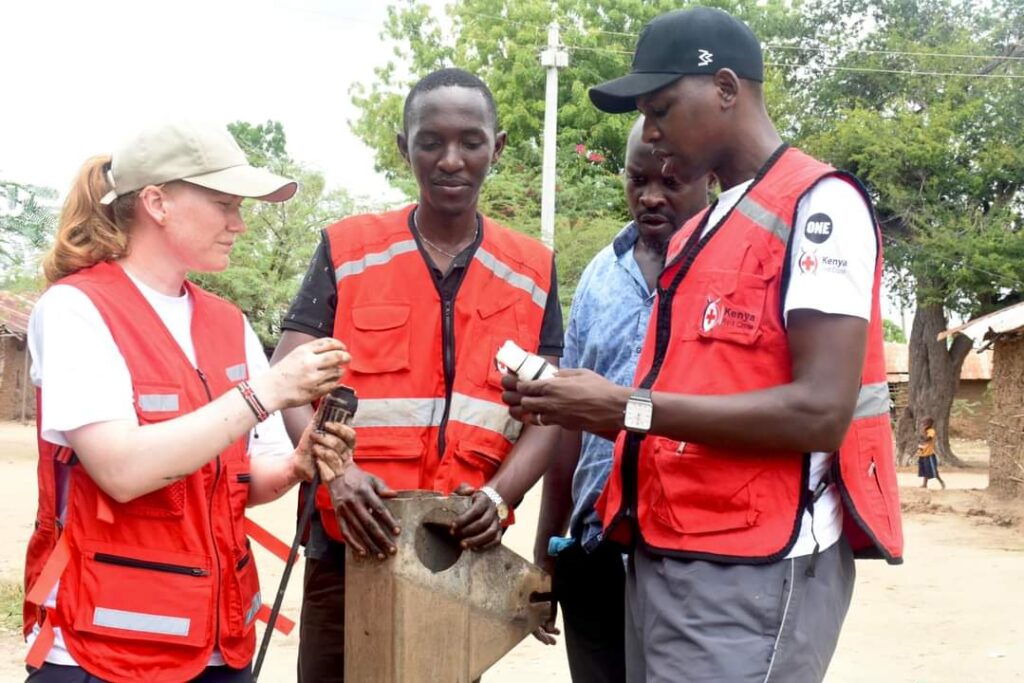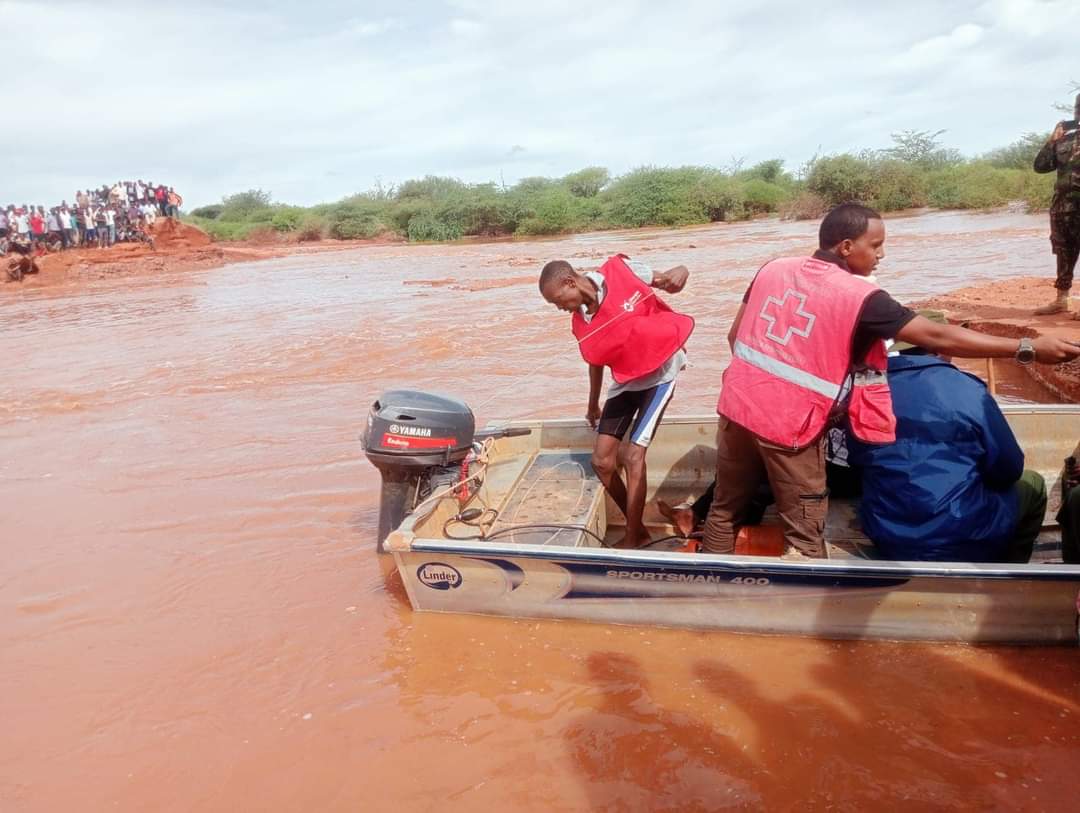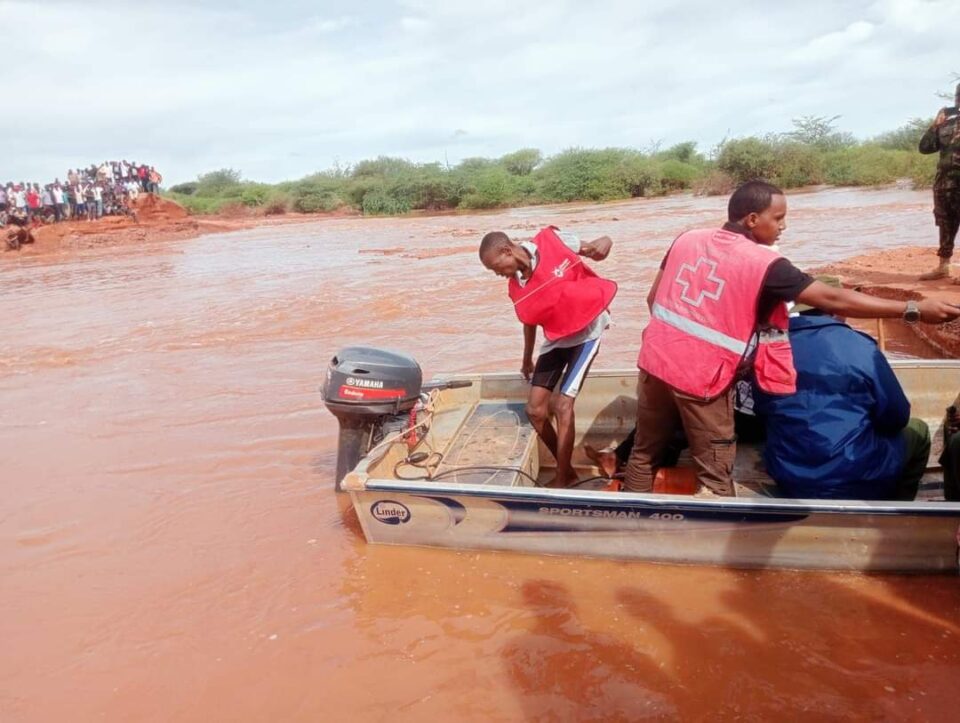In the heart of Kenya’s Tana River region, a dramatic rescue operation unfolded as the Kenya Red Cross sprang into action to save lives endangered by relentless floods. The swift currents of the Tana River, swollen by heavy rains, had trapped a bus and its passengers, highlighting the perilous challenges posed by nature’s fury. As floodwaters surged, leaving communities marooned and roads impassable, the heroic efforts of rescue teams became a beacon of hope in the midst of adversity.


The initial alarm sounded when reports of a stranded bus reached the Kenya Red Cross headquarters, triggering an immediate response. Equipped with specialized rescue gear and a dedicated team of responders, the Red Cross embarked on a mission to reach the stranded passengers and bring them to safety. The urgency of the situation underscored the critical need for coordinated disaster response efforts, especially in flood-prone areas where swift action can mean the difference between life and death.
Upon reaching the site, rescue teams encountered a challenging scenario. The bus, partially submerged in floodwaters, stood as a stark symbol of the forces of nature that had disrupted normalcy. Passengers, some visibly distressed, awaited rescue, their ordeal a testament to the unpredictable nature of natural disasters. The Red Cross, guided by its principles of humanity and compassion, wasted no time in deploying rescue boats and equipment to evacuate the stranded individuals.
Amidst the chaos and urgency of the rescue operation, stories of courage and resilience emerged. Passengers, many of whom had endured hours of uncertainty, expressed gratitude for the timely intervention of the Red Cross. “We thought we were doomed,” remarked one survivor, “but then the Red Cross appeared like angels.” Such testimonials underscored the profound impact of humanitarian efforts in times of crisis, where acts of selflessness restore faith in humanity’s ability to overcome adversity.
As the last passenger was safely evacuated and the bus retrieved from the floodwaters, the focus shifted to the broader impact of the floods on the region. The Kenya Red Cross, in collaboration with local authorities and volunteers, intensified efforts to reach communities cut off by flooded roads. Helicopters became a vital lifeline, airlifting supplies and conducting aerial assessments to identify areas most in need of assistance.
The scale of the disaster became evident as aerial footage captured vast swathes of land submerged under water. Villages transformed into islands, isolated from essential services and supplies, painted a stark picture of the challenges faced by flood-affected regions. The Red Cross’s humanitarian response, spanning rescue operations, medical aid, and distribution of relief supplies, emerged as a beacon of hope amidst the devastation.
In the aftermath of the rescue mission, attention turned to long-term strategies for disaster preparedness and mitigation. Climate change, with its unpredictable weather patterns, has heightened the risk of floods and other natural disasters, necessitating proactive measures to build resilience in vulnerable communities. The Kenya Red Cross, with its expertise in disaster response and risk reduction, advocated for investment in early warning systems, community training, and infrastructure improvements to mitigate future disasters’ impact.
The heroic efforts of the Kenya Red Cross in rescuing stranded bus passengers and assisting flood-affected communities underscored the invaluable role of humanitarian organizations in safeguarding lives and promoting resilience. As the waters recede and communities begin to rebuild, the lessons learned from this crisis serve as a reminder of the collective strength and compassion that define our response to adversity.
Through collaboration, innovation, and unwavering dedication, the Kenya Red Cross and its partners continue to stand as guardians of hope in times of crisis, embodying the spirit of solidarity that binds us together in the face of nature’s challenges.
As the sun rose over the flood-ravaged Tana River region, the aftermath of the Kenya Red Cross’s heroic rescue mission came into sharper focus. The operation to save stranded bus passengers from the merciless grip of floodwaters had not only showcased the organization’s swift response capabilities but also illuminated the challenges and triumphs of disaster management in a climate-vulnerable landscape.
The narrative of the rescue unfolded like a gripping saga, with each moment fraught with tension and determination. The Red Cross’s initial deployment of rescue teams and equipment was just the beginning of a complex operation that tested their skills and resolve. Navigating treacherous currents and rapidly changing conditions, the rescue teams exhibited a level of expertise honed through years of training and experience.
One of the defining moments of the rescue was the use of specialized boats designed for swift-water operations. These agile vessels, manned by skilled responders, became lifelines for those stranded amidst the swirling floodwaters. The precision and coordination displayed in maneuvering these boats through narrow passages and turbulent waters underscored the Red Cross’s commitment to saving every life at risk.
Amidst the logistical challenges of the rescue, the human stories that emerged painted a poignant picture of survival and solidarity. Passengers, young and old, recounted moments of fear and uncertainty as they awaited rescue. “We clung to hope as the waters rose,” shared a survivor, “and then we heard the sound of rescue boats, a sound I’ll never forget.” These testimonials captured the raw emotions of individuals thrust into a crisis beyond their control, yet united by a shared sense of resilience.
The role of technology in the rescue operation was also pivotal. Aerial drones provided real-time assessments of the flood-affected areas, guiding rescue teams to locations with the greatest need. Thermal imaging technology enabled responders to identify individuals in distress, ensuring no one was left behind. The seamless integration of technology into traditional rescue methods showcased the adaptability and innovation driving modern disaster response efforts.
As the rescue mission neared its conclusion, the focus shifted to the broader impact of the floods on the region’s infrastructure and communities. Roads, bridges, and vital lifelines were washed away by the force of nature, isolating villages and hampering access to essential services. The Red Cross’s post-rescue efforts included rapid assessments of infrastructure damage, prioritizing repairs to restore connectivity and facilitate ongoing relief operations.
Medical teams deployed by the Red Cross provided much-needed care to those affected by the floods. From basic first aid to more complex medical interventions, the teams worked tirelessly to address health concerns exacerbated by the disaster. Mobile clinics became hubs of activity, offering a lifeline to communities cut off from healthcare facilities due to flooded roads and impassable terrain.
The distribution of relief supplies, including food, water, shelter materials, and hygiene kits, formed another crucial aspect of the Red Cross’s response. Working in collaboration with local authorities and partners, the organization ensured that essential supplies reached those most in need. Helicopters became lifelines for remote communities, delivering aid to areas inaccessible by road and facilitating the evacuation of vulnerable individuals, including the elderly and the injured.
Beyond the immediate response, the Kenya Red Cross emphasized the importance of long-term resilience-building measures. Community training programs on disaster preparedness, early warning systems, and sustainable infrastructure development were identified as key priorities. The goal was not just to respond to crises but to empower communities to withstand future challenges and bounce back stronger.
In the days following the rescue operation, as floodwaters receded and communities embarked on the path to recovery, the spirit of resilience and solidarity shone brightly. Volunteers, responders, and survivors came together to rebuild what the floods had washed away, embodying the collective strength that emerges in the face of adversity.
The saga of the Kenya Red Cross’s rescue mission amid Tana River floods serves as a testament to the indomitable human spirit and the power of compassionate action. Through courage, collaboration, and unwavering dedication, the organization reaffirmed its role as a beacon of hope in times of crisis, leaving an enduring legacy of heroism and resilience in its wake.

